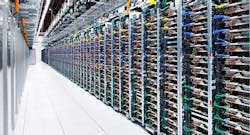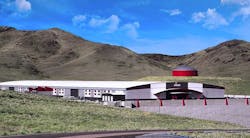The combination of lots of land and cheap renewable power is establishing Reno, Nevada as the new hotspot for massive cloud campuses. Reno’s appeal is reinforced by Monday’s news that Google has bought 1,210 acres at the Tahoe Reno Industrial Center, investing $29 million to lock down land for a future data center campus.
The report comes just weeks after colocation provider Switch opened the first phase of its Citadel Campus at the same location, which at completion will be home to 7.2 million square feet of data center space, making it the largest cloud campus yet. The area is also home to one of Apple’s largest data center projects, which continues to expand at the nearby Reno Technology Park.
The trio of mega-campuses could make the area east of Reno one of the largest clusters of cloud servers in the world. The Tahoe Reno Industrial Center is also home to the Tesla Gigafactory, where automaker will soon be cranking out batteries for its next-generation cars.
The Reno area offers these companies an ample supply of land, access to affordable solar power, and a business-friendly climate with tax incentives for data center providers.
Cloud Campuses Keep Growing
The Google news reinforces the trend toward larger server farms to support the shift of IT capacity from corporate data centers to cloud computing platforms. As we noted back in 2015, the scale of these facilities will continue to grow as cloud computing gains momentum, driven by social networks, Big Data, AI and the Internet of Things.
Reno is the new frontier of the mega-scale cloud campus, featuring massive data centers powered entirely by renewable energy. It is the latest sign of the way that cloud computing is reshaping America’s Internet infrastructure, focusing IT capacity in energy-efficient hubs that leverage the latest advances in data center design and energy procurement.
Data center hubs offer economies of scale, enabling companies to rapidly add server capacity and electric power as more workloads shift from in-house IT rooms into these massive server farms. It has become routine for companies like Apple, Google, Facebook and Microsoft to invest more than $1 billion in a single location where they place a cloud campus.
An example: Facebook has been super-sizing its data center campuses, and just announced its largest yet in Papillion, Nebraska.
Cheap Renewable Energy Could be Key Attraction
Google isn’t yet commenting about its plans in Reno. The huge size of the property has led to speculation that the company’s plans include more than a data center, perhaps including a test track for the autonomous vehicles being developed by Google’s Waymo unit.
Here’s the reality: Google could easily use the entire 1,200 acres for a cloud campus. It’s done it before. In Council Bluffs, Iowa, the company bought 1,000 acres of land in 2007, and begin building data centers on it in 2011. In just six years, Google has nearly filled the property with data centers. After starting with a two-story data center design, Google has since shifted to four-story buildings to get more mileage out of its real estate at the site.
One reason Google may have big plans in Reno is the company’s appetite for affordable renewable energy. Nevada is a prime location for photovoltaic solar arrays, and data center providers have been able to procure solar power at between 4 and 5 cents per kilowatt hour (kWh), well below the national average of 11 cents per kWh.
Google is one of the largest commercial purchasers of renewable energy, and may see the Reno site as an opportunity to house a considerable chunk of its new capacity in a green power market. Apple recently revealed plans to support its Reno campus with a solar power farm with future capacity of 200 megawatts.
Switch Builds Big With Citadel Campus
If Apple and Google follow through and procure renewable power in Reno, they will be walking a path blazed by Switch, which expanded to Reno after building the massive SUPERNAP cloud campus in Las Vegas.
At the start of 2016 Switch announced that its Las Vegas SUPERNAP campus was fully powered by renewable energy from NV Energy. The company has contracted for more than 180 megawatts of power from solar, wind and geothermal power sources in Nevada to supports its data centers in the state.
The Tahoe Reno 1 data center at the Switch Citadel Campus spans 1.3 million square feet, the largest colocation center ever built. (Photo: Switch)
When Switch first pursued going 100 percent green in Nevada in late 2013, NV Energy had no green energy tariff. Switch became the first company in Nevada to have a direct access case heard in front of the Public Utilities Commission of Nevada (PUCN), and joined with Tesla and other major electricity customers to support a successful ballot initiative in 2016 that would eliminate NV Energy’s monopoly and allow customers to choose their electricity provider. That allows Switch and other data center providers (including Google) to work directly with solar energy providers to provision renewable power for their Nevada data centers.
As a result, Switch customers in Reno (which include anchor tenant eBay) can access green power at rates as low as 4.9 cents per kilowatt hour. At 1.3 million square feet, the new Switch Tahoe Reno 1 facility is the largest colocation facility ever built, and is supported by up to 130 megawatts of renewable power. The first data center is a down payment on an even larger vision for the 2,000 acre Citadel Campus, where Switch intends to deploy 650 megawatts of data center capacity.
Apple Continues Reno Expansion
Apple doesn’t say much about its data center operations. But it was the first major tech company to select Reno for a major cloud campus when it began to build at the Reno Technology Park. The growing facility helps Apple deliver iTunes, iCloud and other online services to its huge audience of users around the world.
Apple has built more than 400,000 square feet of data center capacity in Reno, and has filed plans for several major expansions, according to media reports. The first is Project Huckleberry, which would create a second cluster of buildings spanning another 400,000 square feet. More recently, an expansion code-named Project Isabel was revealed, which could mean another 378,000 square feet of data center space.
While it’s hard to sort out the multiple expansions, the combined reports suggest that Apple may soon have a cloud campus in Reno spanning nearly 1.2 million square feet of data center space.
Rackspace has also sought tax incentives to build a 150,000 square foot data center near Reno, but it’s not clear if the company has begun construction or remains committed to the project in the wake of its acquisition last year by a private equity firm. The company’s global infrastructure map does not include any mention of a Reno data center.
What About Tesla?
Is there any magic in the clustering of data centers surrounding the Tesla Gigafactory in Reno? Not at the moment, but Tesla could one day be a facilitator of a larger shift to the use of green energy in data centers. In addition to its car batteries, Tesla’s line of PowerWall batteries offers energy storage in capacities that allow it to be considered for data center use.
The Tesla Gigafactory at the Tahoe Reno Industrial Park. The 1.9 million square foot facility commenced battery production in January. (Image: Tesla)
Amazon Web Services has been conducting a pilot test of a 4.8 megawatt installation of of Tesla’s energy storage batteries in its US West (Northern California) data center region.
“Batteries are important for both data center reliability and as enablers for the efficient application of renewable power,” said James Hamilton, Distinguished Engineer at Amazon Web Services. “They help bridge the gap between intermittent production, from sources like wind, and the data center’s constant power demands. This complements our strategy to use renewable energy to power our global infrastructure.”
The Tesla battery technology has yet to demonstrate the scale needed to become a viable option for most data centers, but offers a potential future path for the cloud builders.
One person who has thought a lot about energy storage is Joe Kava, who runs Google’s data centers. In a 2015 interview, Kava talked with Data Center Frontier about the role batteries could play as an enabler of renewable enrgygreen power in data centers.
“I think the tipping point for utility-scale renewables will be the next-generation of utility-scale energy storage,” said Kava. “As soon as real large-scale energy storage is available, I think that will bring more renewables in the grid.”
About the Author





